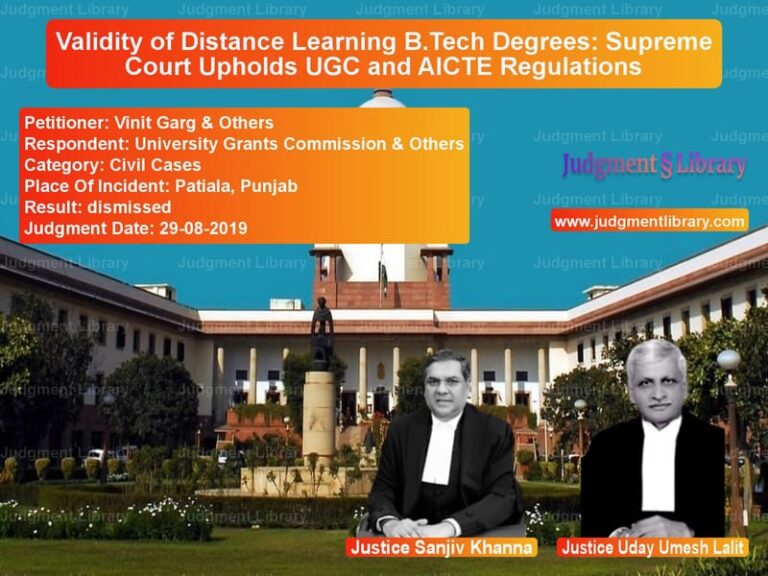Supreme Court Modifies Compensation Award in Land Acquisition Case
The Supreme Court of India, in the case of Sajan v. State of Maharashtra & Ors., ruled on a long-standing land acquisition dispute regarding compensation for land acquired for the construction of Hiwra Dam. The Court modified the compensation amount, increasing the valuation of the land and setting a new precedent for determining development deductions in acquisition cases.
Background of the Case
The dispute arose when the government acquired land in Gat No.85 at Mhasekota, Tehsil Soyegaon, District Aurangabad, under the Land Acquisition Act, 1894, for the construction of the Hiwra Dam project. The land belonged to a partnership firm and was used for both agricultural and non-agricultural purposes, including a sugar factory.
The Special Land Acquisition Officer (SLAO) awarded compensation based on the value of the land and infrastructure, but the claimants sought enhanced compensation, arguing that the awarded amount undervalued the property and failed to account for business losses incurred due to the acquisition.
Petitioner’s Arguments
The appellants (landowners) raised the following key arguments:
- “The compensation determined by the SLAO was significantly lower than the actual market value of the land.”
- “The land had high commercial value and should have been valued at Rs.10 per sq. ft., amounting to Rs.1,69,45,111/-.”
- “A mere 10% deduction for development costs was reasonable instead of the 40% applied by the High Court.”
- “The loss of business suffered due to the shutdown of the sugar factory should be adequately compensated.”
Respondent’s Arguments
The State of Maharashtra, defending the compensation awarded, contended:
- “The Reference Court erred in considering undeveloped land as non-agricultural, leading to inflated compensation.”
- “The land was located in a remote village with no commercial potential, justifying the deduction for development costs.”
- “There was no evidence that the sugar factory was operational or profitable at the time of acquisition.”
- “The High Court reasonably adjusted compensation based on expert valuation and past transactions.”
Supreme Court’s Observations
The Supreme Court reviewed the valuation certificates, expert testimonies, and past sale transactions before delivering its ruling. The Court made the following observations:
“The deduction towards development costs should be reasonable and reflective of the actual state of the land at the time of acquisition. A 20% deduction, rather than 40%, is appropriate in this case.”
Regarding business losses, the Court held:
“There was no documentary proof to support the claim that the sugar factory was generating a profit of Rs.2,00,000 per year. However, a reasonable compensation of Rs.5,00,000 for business loss is justified.”
The Court further stated:
“The land’s potential for non-agricultural use must be considered, but an overestimation of value based on speculative commercial potential cannot be allowed.”
Final Judgment
The Supreme Court modified the compensation award as follows:
- Increased the compensation for land value from Rs.9,40,896 to Rs.14,42,707 by applying a 20% deduction for development instead of 40%.
- Affirmed the Reference Court’s valuation of dismantling and damages of civil work at Rs.4,26,890.
- Enhanced compensation for electrical installations from Rs.2,39,000 to Rs.3,86,867.
- Confirmed the depreciated value of machinery and mechanical installation at Rs.6,62,000.
- Maintained the compensation for business loss at Rs.5,00,000.
Key Takeaways
- The ruling clarifies that deductions for development costs should be reasonable and aligned with the specific nature of the acquired land.
- Business losses must be supported by documentary evidence to warrant enhanced compensation.
- The Court’s approach in modifying compensation provides a precedent for fair valuation in future land acquisition cases.
- The decision underscores the importance of considering potential non-agricultural use while ensuring compensation is based on real market trends.
Impact of the Judgment
The ruling sets a benchmark for assessing compensation in land acquisition cases and protects the interests of landowners while balancing governmental responsibilities. The revised compensation ensures a fair valuation mechanism and prevents excessive deductions based on generalized assumptions.
Conclusion
The Supreme Court’s decision modifies the compensation calculation methodology in land acquisition cases, ensuring fairness and adherence to legal principles. By correcting the deductions applied by the High Court and ensuring just compensation for landowners, the ruling strengthens transparency and credibility in land acquisition proceedings.
Petitioner Name: Sajan.Respondent Name: State of Maharashtra & Ors..Judgment By: Justice R. Banumathi, Justice A.S. Bopanna.Place Of Incident: Aurangabad, Maharashtra.Judgment Date: 17-03-2020.
Don’t miss out on the full details! Download the complete judgment in PDF format below and gain valuable insights instantly!
Download Judgment: Sajan vs State of Maharashtra Supreme Court of India Judgment Dated 17-03-2020.pdf
Direct Downlaod Judgment: Direct downlaod this Judgment
See all petitions in Property Disputes
See all petitions in Damages and Compensation
See all petitions in Contract Disputes
See all petitions in Judgment by R. Banumathi
See all petitions in Judgment by A. S. Bopanna
See all petitions in partially allowed
See all petitions in Modified
See all petitions in supreme court of India judgments March 2020
See all petitions in 2020 judgments
See all posts in Civil Cases Category
See all allowed petitions in Civil Cases Category
See all Dismissed petitions in Civil Cases Category
See all partially allowed petitions in Civil Cases Category







